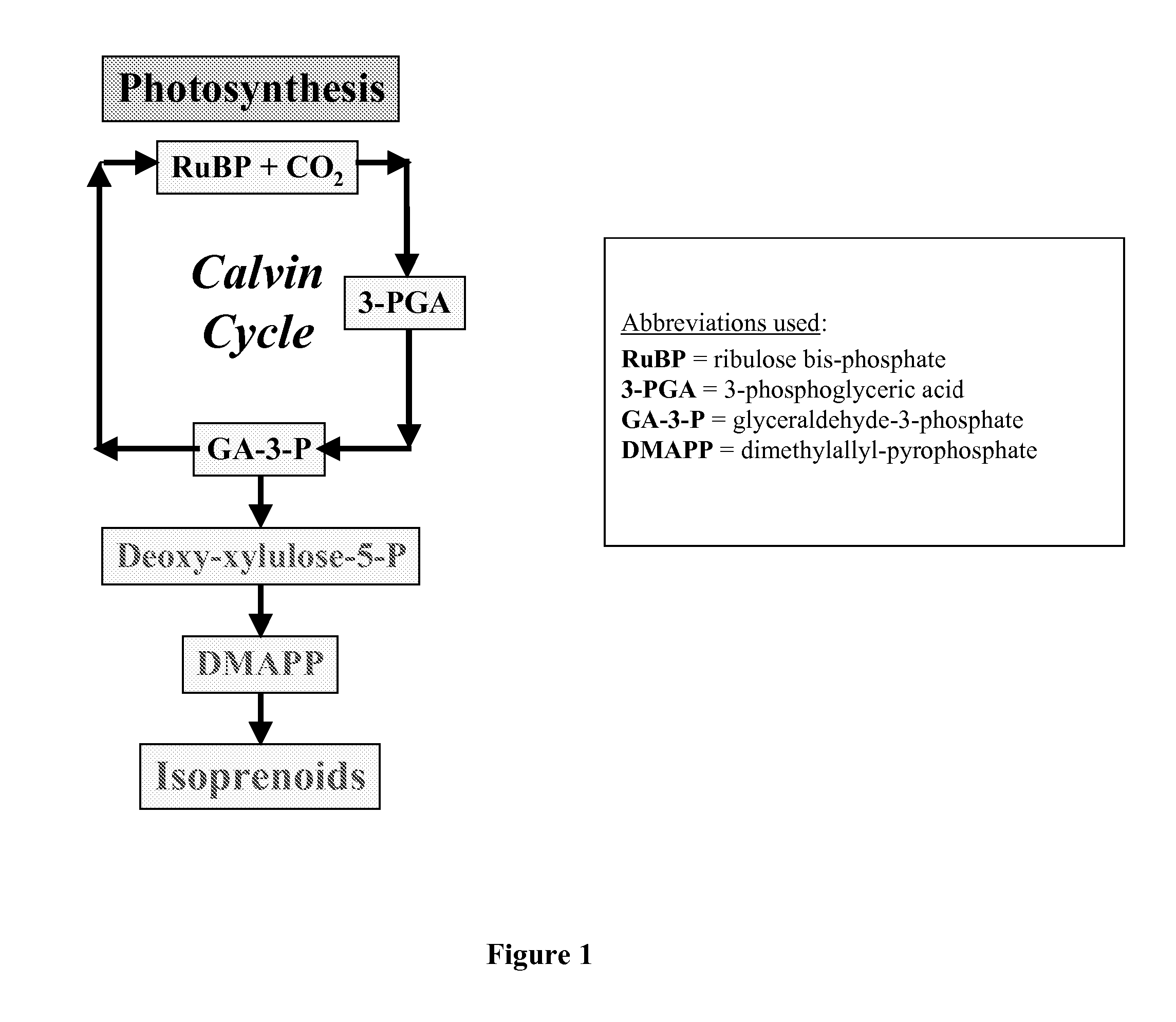Short chain volatile hydrocarbon production using genetically engineered microalgae, cyanobacteria or bacteria
a technology of genetically engineered microalgae and short-chain hydrocarbons, which is applied in the direction of lysine, polypeptides with his-tags, microorganisms, etc., can solve the problems of undesirable pollution of the atmosphere by short-chain hydrocarbon emissions of plants, and achieve the effects of reducing production costs, reducing fuel weight/volume ratio, and growing and reproducing faster
- Summary
- Abstract
- Description
- Claims
- Application Information
AI Technical Summary
Benefits of technology
Problems solved by technology
Method used
Image
Examples
example 1
Design and Expression of Novel Cr-IspS Gene for Isoprene Hydrocarbon Production in Microalgae
[0089] A codon-adjusted synthetic DNA construct was generated based on the known nuclear-encoded “isoprene synthase” IspS protein sequence of Populus alba (poplar). This amino acid sequence (SEQ ID NO:2) was used as a template for the de novo design of an IspS DNA sequence for expression of the gene in the chloroplast of model microalga Chlamydomonas reinhardtii. For the purposes of this invention, this gene has been termed Cr-IspS. Features of this gene included: (1) Codon usage was different from that of poplar and specifically selected to fit the codon usage of the Chlamydomonas reinhardtii chloroplast; (2) The poplar chloroplast targeting sequence of the protein was omitted from the design of the new Cr-IspS gene. (3) Three copies of a codon optimized gene encoding the hemagglutinin (HA) epitope tag were fused upstream of the IspS gene.
[0090] The Cr-IspS DNA sequence (SEQ ID NO:3) was ...
example 2
Design and Expression of a Ss-IspS Gene for Isoprene Hydrocarbon Production in Cyanobacteria
[0096] In order to express isoprene hydrocarbon production in cyanobacteria, a codon-adjusted synthetic DNA construct was generated, based on the known isoprene synthase IspS protein sequence of Populus alba (poplar). This amino acid sequence was used as a template for the de novo design of an IspS DNA sequence for expression of the gene in cyanobacteria, e.g., Synechocystis sp. Codon usage adjustments for gene expression in cyanobacteria were made on the basis of the codon usage Table for Synechocystis PCC 6803, listed in the following URL: http: / / gib.genes.nig.ac.jp / single / codon / main.php?spid=Syne_PCC6803.
[0097] The codon-adjusted gene is referred to herein as Ss-IspS. Features of this gene include: (1) Codon usage was different from that of poplar and specifically selected to fit the codon usage of Synechocystis; (2) The poplar chloroplast targeting sequence of the protein was omitted fr...
example 3
Expression of His-Tagged IspS in Escherichia coli
[0102] In order to construct the vector for expression of His-tagged IspS gene in E. coli, Ss-IspS DNA, codon optimized for expression in cyanobacteria, was amplified by PCR using primers:
IspS_F_NdeI,5′-CTGGGTCATATGGAAGCTCGACGAA-3′,andIspS_R_HindIII,5′-ATGGAAAACCTGAAGCTTTTAACGTTCAA-3′,;
introducing an Nde I-site and a Hind III-site in the 5′ and 3′ end of the gene, respectively. These sites were used to clone the gene into the pET1529 expression vector forming vector pETIspS, which carries a His-tag in the N-terminal end of the protein (FIG. 11).
[0103] In order to demonstrate recombinant His-tagged Ss-IspS expression in Escherichia coli, E. coli bacteria were transformed with the pETIspS plasmid, which contains the Ss-IspS gene and a His-tag-encoding DNA in the 5′ end of the Ss-IspS gene. Successful expression of this His-Ss-IspS gene in E. coli was induced upon addition of 0.1 mM IPTG to the liquid cell culture. Cells were harves...
PUM
| Property | Measurement | Unit |
|---|---|---|
| Tm | aaaaa | aaaaa |
| temperature | aaaaa | aaaaa |
| temperature | aaaaa | aaaaa |
Abstract
Description
Claims
Application Information
 Login to View More
Login to View More - R&D
- Intellectual Property
- Life Sciences
- Materials
- Tech Scout
- Unparalleled Data Quality
- Higher Quality Content
- 60% Fewer Hallucinations
Browse by: Latest US Patents, China's latest patents, Technical Efficacy Thesaurus, Application Domain, Technology Topic, Popular Technical Reports.
© 2025 PatSnap. All rights reserved.Legal|Privacy policy|Modern Slavery Act Transparency Statement|Sitemap|About US| Contact US: help@patsnap.com



